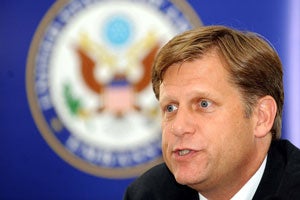If you sup with the Russian government, you’d better bring a long spoon. While some U.S.–Russian cooperation appears to be happening on the surface, behind the smiles, nasty surprises are often waiting. No one knows this better than U.S. Ambassador to Russia Michael McFaul, who assumed his post in January.
McFaul has been subject to systematic harassment by thugs belonging to the Russian youth group Nashi as well as the Russian media. The attacks started soon after McFaul’s arrival but have intensified in recent weeks. McFaul has even been accused of “arrogance” by Russian Foreign Minister Sergei Lavrov, who, like his boss Vladimir Putin, seethes over U.S. missile defense plans.
The response to the Russian provocations from the U.S. State Department have not made much of an impact, nor would one expect them to. McFaul understandably erupted in anger at being followed everywhere by Russian NTV, but he later apologized on Twitter. In a tough culture like Russia—and an even tougher city, Moscow—a much harder line from the U.S. government would be needed to make an impact, such as a credible threat to suspend cooperation, aid, or ongoing programs.
In addition to the outrageous and unacceptable attacks on the U.S. ambassador, other examples of anti-Americanism include Putin’s reaction to the popular protests that erupted in Moscow after the Russian parliamentary elections in December and also in March following the Russian presidential elections. President-elect Putin actually blamed the demonstrations on Hillary Clinton and the U.S. State Department, accusing Clinton of “giving the signal” to the protestors. Putin further called opposition leaders “jackals scavenging near Western embassies” and “monkey packs.”
Now, American officials have reportedly been assured that all this anti-U.S. rhetoric streaming out of Moscow was simply a populist tactic in the election. Is this really to be believed? Of course not.
For the Russian government, using the U.S. as variously a whipping boy and a scarecrow is extremely convenient. Indeed, anti-Americanism is a long-standing and fundamental pillar of Russian foreign policy and public diplomacy. As noted by Heritage’s Ariel Cohen, “Anti-Americanism in Russia is rampant. Putin has relentlessly created an image of Russia under attack from Western enemies. It worked for the elections and is likely to continue as a pillar of Russia’s domestic and foreign policy.”
Anti-American rhetoric is also a standard feature of the broadcasts of Russia Today, the Kremlin’s international news channel, which can be found on many American cable systems. However, while Russian commentators can spew allegations with impunity, the U.S. government’s Radio Liberty and Voice of America (VOA) are banned or severely curtailed in most Russian media markets. In fact, prior to the Russian presidential election, VOA broadcasters were warned against covering Russian election issues under threat of being kicked off the market altogether. The fact that the U.S. media market is free leaves it open to abuses. Nevertheless, a tougher approach to reciprocity in media access is clearly needed.
Recently confirmed Undersecretary for Public Diplomacy Tara Sonenshine has already met with Russian special presidential representative Mihkail Shvydkoy at the State Department to discuss future plans for U.S.–Russian collaboration on media, education, sports, and professional exchanges. This working collaboration was set up initially as part of the great Obama “reset” in relations, and the stated purpose is to promote dialogue and understanding between Russians and Americans.
But surely, as long as the leadership of Russia sees fit to launch personal attacks on the Secretary of State and the U.S. ambassador, public diplomacy is not likely to do a whole lot of good. That should be the message from the U.S. State Department.






























